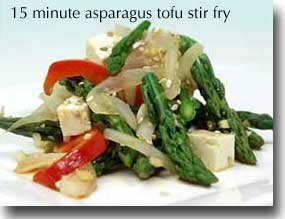healthy food tip and recipe
Today's Recipe
If you don't know what to serve for dinner tonight ...
Add this quick-and-easy vegetarian meal to your Healthiest Way of Eating this week. Prepared by using our Healthy Sauté cooking method it has great flavor with a minimal number of ingredients and is prepared without the use of heated oils. Enjoy!

Ingredients:
- 1 medium onion, cut in half and sliced medium thick
- 4 medium cloves garlic, chopped
- 1 TBS vegetable broth
- 2 TBS minced fresh ginger
- 3 cups thin asparagus, cut in 2-inch lengths
- 1 medium red bell pepper, thin julienne in 1-inch lengths
- 4 oz extra firm tofu, cut in 1/2-inch cubes
- 1 TBS soy sauce
- 2 TBS rice vinegar
- 1 tsp toasted sesame seeds
- salt and white pepper to taste
- Slice onions and chop garlic and let both sit for at least 5 minutes to bring out their hidden health benefits.
- Heat 1 TBS broth in a 10-12 inch stainless steel skillet. Healthy Sauté onion in broth over medium high heat for about 2 minutes, stirring constantly.
- Add garlic, ginger, asparagus, and peppers and continue to healthy sauté for another 1 minute, stirring constantly.
- Add tofu, soy sauce, and vinegar. Turn heat to low and cover for about 2 minutes, or until vegetables are tender, yet still crisp.
- Season with salt and pepper and sprinkle with sesame seeds.
In-Depth Nutritional Profile for 15-Minute Healthy Sautéed Asparagus and Tofu
Healthy Food Tip
Is juicing your greens as healthy as eating them?
No, juicing your greens is not nearly as healthy as eating them,
provided that you use healthy cooking methods when you prepare the
greens. For example, if you overcook the greens, you will lose too many
of the nutrients they contain; in that case, you might be worse off than
if you used a juicer. But as long as you use the healthy steaming or
other cooking methods I describe in The World's Healthiest Foods book,
you'll get a far greater variety of nutrients in the whole greens than
in the juice.
That's because juicers usually separate the juice from the solids in the leaves, stems, or stalks (which some people call the pulp), all of which are then discarded. Unfortunately, these portions of the greens often contain a majority of the total nutrients, including fiber and many phytonutrients including certain carotenoids and flavonoids. If you added all of the discarded portions back into the juice, you would be getting very close to the same nutritional benefits as the vegetable itself. However, many people find a juice with 100% pulp to be unpleasantly thick and displeasing in taste.
I've seen websites promoting the value of live enzymes from freshly juiced greens, and even though I have not seen research to support this claim, there may indeed be some benefit inside of the digestive tract to the consumption of freshly juiced, organic greens. I do know that very fresh (short time from harvest) raw foods that are harvested and handled with care can deliver some functioning enzymes into our digestive tract when we eat those raw foods. However, there is no research showing that we would be able to absorb these enzymes into our body and make use of them outside of the digestive tract.
Many juicers come with a recipe book showing how the vegetable pulp can be used in recipes. This idea makes good sense to me and would be a way of salvaging some of the nutrients that were lost during the process of juicing.


No comments:
Post a Comment